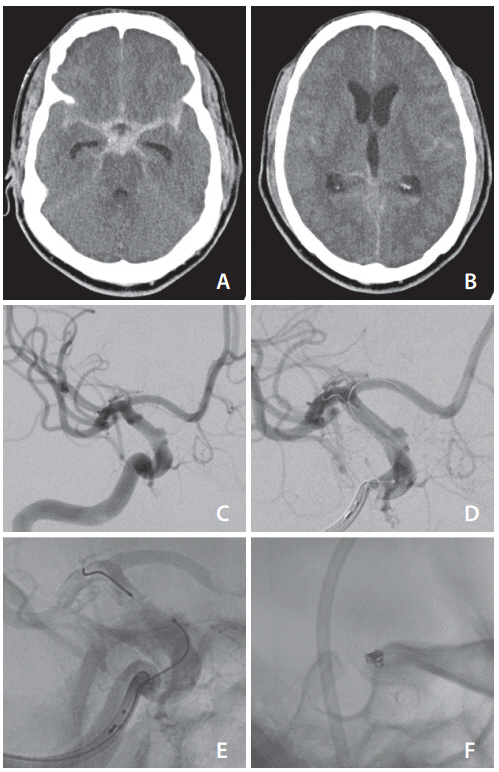Neurointervention.
2021 Jul;16(2):171-174. 10.5469/neuroint.2020.00444.
Electrothermal Coil Detachment Failure in Flow Diverter-Assisted Coiling of a Small Blister Aneurysm: Technical Considerations and Possible Solutions
- Affiliations
-
- 1Department of Surgery (Neurosurgery), Dalhousie University, Halifax, NS, Canada
- 2Department of Radiology (Neuroradiology), Dalhousie University, Halifax, NS, Canada
- KMID: 2517743
- DOI: http://doi.org/10.5469/neuroint.2020.00444
Abstract
- Flow diversion stenting combined with coiling offers both immediate protection from rebleeding for ruptured aneurysms and long-term stability for wide-necked or blister aneurysms. It is particularly useful for tiny ruptured aneurysms, alleviating the concern that small coils may prolapse between the struts of conventional stents. We employed this technique in a very small, broad-based ruptured aneurysm of the internal carotid, jailing the coiling microcatheter with a Pipeline Embolization Device. However, coil detachment repeatedly failed, until we withdrew the detachment zone into the microcatheter. We suggest that if the tip of the coiling catheter is adjacent to the stent, contact between the junction zone of the coil and the high metal density of the flow diverter may prevent proper electrothermal coil detachment. Detachment can be undertaken successfully within the microcatheter, though care must be taken thereafter to fully push the detached coil tail into the aneurysm.
Keyword
Figure
Reference
-
1. Dornbos D 3rd, Pillai P, Sauvageau E. Flow diverter assisted coil embolization of a very small ruptured ophthalmic artery aneurysm. J Neurointerv Surg. 2016; 8(e1):e2–e4.
Article2. Kim YS, Lee SW, Yeom JA, Yoon CH, Baik SK. Alternative detachment technique for electrically detachable coils: rescue from an unintended complication. Oper Neurosurg (Hagerstown). 2015; 11:569–574.
Article3. Lee CY, Yi MB, Benndorf G. Mechanical detachment of Guglielmi detachable coils after failed electrolytic detachment: rescue from a technical complication. Neurosurgery. 2008; 63(4 Suppl 2):293–294; discussion 294.
Article4. Guglielmi G, Viñuela F, Dion J, Duckwiler G. Electrothrombosis of saccular aneurysms via endovascular approach. Part 2: preliminary clinical experience. J Neurosurg. 1991; 75:8–14.5. Guglielmi G. Accurate positioning of detachable coils using alternate electric current. A technical note. Interv Neuroradiol. 2006; 12:103–107.
- Full Text Links
- Actions
-
Cited
- CITED
-
- Close
- Share
- Similar articles
-
- A Complicated Case of Endovascular Stent Assisted Coil Embolization of an Aneurysm
- Technical Approaches for Coil Embolization of Unruptured Small Anterior Choroidal Artery Aneurysms: A Focus on Anatomical Flow Preservation of the Anterior Choroidal Artery
- Blood Blister-like Aneurysm Treated with Coil Embolization without Stent Assistance
- Endovascular Treatment of Cerebral Aneurysms: Coiling Techniques
- Kinking of Flow Diverter in a Giant Wide-Necked Supraclinoid Internal Carotid Artery Aneurysm


